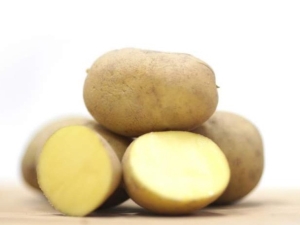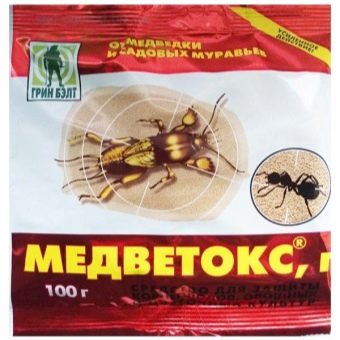Potato "Karatop": characteristics and characteristics of cultivation

German agronomists obtained a hybrid of early ripe potatoes, which is suitable for planting in a mild continental climate.He came to Russia in 2000 and gained quite a lot of popularity. It is planted on a variety of farms, homestead and country farms.
Variety description
The body of the fruit of potato varieties "Karatop" slightly yellowish color, covered with a slightly rough skin. The flesh has a small grain. The eyes are small, are on the surface of the fruit of the potato. Tubers are not large, maximum weight - up to 100 grams. They themselves are oval and oval-round in shape. Starch content, as in table varieties - 10-15%.
Shrubs are characterized by large tops with a relatively small size of the stem - up to 60 cm in height. Stems are semi-upright. The color of the stem is green, has a mild green color. The tops are medium-spruce. The flowers during the growing season are white. The leaves on the bushes are medium in size and of a clear form. Roots of plants have a wave shape.
Characteristics of a variety
The variety is early ripening, the maximum duration of ripening of this variety is 65 days. The harvest is very large - up to 50 tons of potatoes per hectare of sown areas. On one bush on average is up to 25 tubers.
Practically any soil is suitable for planting, the only thing is that additional assistance to the plant in the form of loosening the earth and fertilizing it is necessary to render it only on very heavy soils.
In a variety of sources, when describing a variety, emphasis is placed on the fact that it is well preserved in the winter period and it has a very low percentage of damage (less than 4%). Also, it is well tolerated transportation.
One of the characteristics of the variety "Karatop" is that it loves moisture and requires frequent watering. If this is not done, then the yield will fall sharply.
Hybrid perfectly resists diseases that are characteristic of different varieties of potatoes. These are potato cancer, glandular spotting, Y and A viruses, nematode, late blight, or brown rot of tops. But with late blight tuber variety poorly.
Many people appreciate the taste of the potato "Karatop" very high, almost 5 points out of 5. This variety is well boiled soft during cooking, and is perfect for cooking all kinds of dishes, ranging from mashed potatoes to fried potatoes and fries.
Preparation of tubers for planting
Last year's potatoes come from the place of their storage, whole, intact tubers of medium size are selected (very large and small seedlings are poorly suited). The focus of the selection is on the number of eyes on the potatoes - the more there are, the more the vegetable is able to grow. Also, the body of the selected potato must be dense, without any softness. After all, if the potato has become soft, then this means that it does not have enough moisture.
The container containing potatoes is exposed to the lighted place and dried out at an ambient temperature of not more than 15 ° C.
Two weeks before planting, potatoes are germinated. To do this, moisten sawdust in a bucket and mix them with potatoes. Following wet potatoes removed from the bucket with wet sawdust, again placed in boxes. In order to preserve the heat in which it is located, it is covered on top with plastic wrap, making sure that the potatoes are not covered tightly. He needs air access. After 10-12 hours, the potatoes are poured with sawdust or earth between the layers (not more than three) and left in this state until it is planted. By this time he should have given good sprouts.
Landing
In autumn they prepare the soil by plowing or digging it. In the spring, plowing is poured over with compost, wood ash and superphosphate. Next, level the future of the field under the potato rake. In the process of this is mixing the earth with nutrients.
Trenches are digging with a distance between each 60 centimeters in length during the entire planting of potatoes. Observance of the optimal distance between the rows is very important, as the bushes need space for the root system, respectively, for the growth and development of the plant. These trenches are future rows of potatoes.
The depth of the trench depends on the type of soil. If it is sandy, then ditches are made deeper - 10-15 centimeters, if clay or loam - then 5-8 centimeters.
Next begins the planting of potatoes directly. It is laid on the bottom of each trench with a distance of 30-35 cm between potatoes. Following the trench, they are carefully covered with earth using a rake.
This potato variety can be planted under the film. For this, unlike the method described above, large potatoes are selected for germination. The germination procedure is exactly the same as for medium-sized potatoes, only the temperature should be kept slightly lower - within 14 ° C. Potatoes are also germinated for a longer period - up to 45 days, wetting it with water every 7 days.
The landing occurs from the second half of March until the end of the month. The place where the tubers are planted should be brightly lit and warm up well. Before planting, the potato field is fertilized.
Planting is also carried out in trenches and with the same distance between tubers, as in the method described above. The only thing that the planting depth of the tuber should not exceed 10 centimeters.
After sowing the seed, the beds are covered with a film and do not lift it even for ventilation until the first sprouts appear.
After the sprouts of future potato bushes appeared, small holes are made in the film, 10-15 millimeters, for admission to the air shoots. It is recommended to make holes in a staggered order of several pieces above each bush.
When the ambient air temperature rises to 18–20 ° C during the day, the film is removed for a day, covering the potatoes again overnight. After the soil is completely warmed up and there is no threat of night frost, the film is removed completely.
Approximately once a week it is necessary to feed the plant, for which a liquid mixture of compost or industrial fertilizer is used. The latter are liquid mixtures of either ammonium sulphate or urea, the amount of which in solution is calculated with respect to the fertilized area for every 1 m2. So, for example, for every 1 m2 you need to use 25 grams of sulphate or 12 grams of urea in a solution. This nutrient mixture bushes just watered.
Care
Caring for the variety "Karatop" is no different from caring for other varieties of potatoes and includes:
- Loosening. Starting from the 6th day after planting the potatoes, the soil is periodically loosened. This is done in order to destroy weeds, to give air access to the tubers and to keep the liquid in the soil.
- Hilling. Produced by peat chips or ground. Designed to protect plants from weeds and a sharp decrease in temperature, for example, during the night.
- Watering. Before flowering should be carried out at least once a week. After the potatoes bloom - at least twice a week. This variety does not tolerate too hot weather and drought.
- Plant nutrition. It is necessary to produce a periodic plant fertilization in order to get a good harvest. Until flowering bushes are necessary for the development of phosphorus, for the normal formation of tubers - potassium.
- Pest Control. Of course, the most important insect pest of potatoes is the Colorado potato beetle. It is necessary to periodically spray the bushes with various insecticides that cause the death of this pest, for example, Corado. To protect against another no less nasty pest - the Medvedka, when planting a vegetable in the ground use "Medvedox", sprinkling it around the tubers and burying it with them.
Collection and storage
In order to get the maximum yield, “Karatop” potatoes begin to be harvested from the 50th day. To keep it longer, dry it, choose only healthy fruits for storage and lower it into a dark, cool place. It is desirable that the temperature at the storage location does not exceed 6 ° C, and the potatoes will begin to germinate.
In addition, there should be low humidity, as high will cause mold in the vegetable, and it will start to disappear.
Reviews
If you look at the reviews of people who are engaged in the cultivation of potato varieties "Karatop", then you can immediately determine the general trends. Firstly, it is noted that this variety is not as strongly susceptible to the attacks of the Colorado potato beetle, as many other varieties. That is, the beetle, of course, eats it, but only in those cases when there is no other choice. If there are a number of other varieties or even tomatoes, the Colorado potato beetle will rather switch to them.
Also, many note that such a characteristic of the variety, as an excellent taste, is also present. It is perfectly amenable to various types of cooking.
Many people have a bountiful harvest from Karatop. Some gardeners are even surprised at the amount of potatoes produced in comparison with other varieties. The fact that the potatoes are not very large, is considered a plus. According to some opinions, such a size of fruits is more convenient in storage, transportation and cooking than potato giants.
There are many comments that the variety tolerates storage in the basement in winter and that there are very few missing tubers among them. It also notes its resistance to mechanical damage, for example, in the process of digging, loading and unloading and transportation, which is also one of the great advantages of this variety.
See the following video for tips on growing potatoes.

































